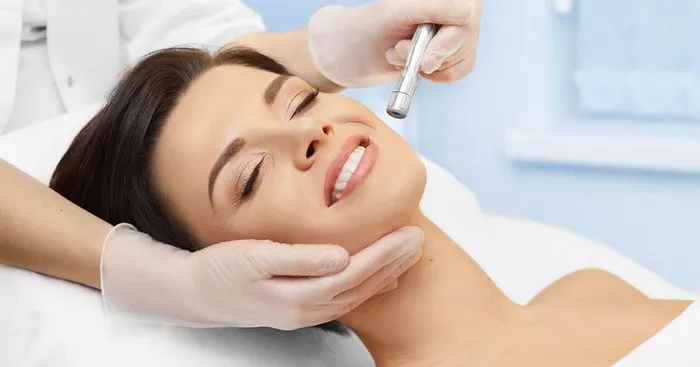Microdermabrasion is a popular cosmetic procedure that involves removing the outer layer of skin to reveal a smoother, more youthful-looking complexion. While microdermabrasion is generally safe and effective, many people experience peeling after the procedure. In this article, we will discuss whether peeling after microdermabrasion is normal and what you can do to manage it.
What is Microdermabrasion?
Microdermabrasion is a non-invasive cosmetic procedure that involves using a special device to exfoliate the outer layer of skin. The device uses tiny crystals or a diamond tip to remove dead skin cells and other debris from the skin’s surface. Microdermabrasion can help to improve the appearance of fine lines, wrinkles, age spots, and other skin imperfections.
Peeling After Microdermabrasion: Is it Normal?
Peeling after microdermabrasion is a common side effect of the procedure. The peeling usually occurs a few days after the procedure and can last for up to a week. The peeling is a result of the exfoliation process, which removes the outer layer of skin and stimulates the growth of new skin cells. The peeling is typically mild and can be managed with proper skincare.
Why Does Peeling Occur After Microdermabrasion?
Peeling after microdermabrasion occurs as a result of the exfoliation process. During microdermabrasion, the outer layer of skin is removed, which can cause the skin to become dry and flaky. The skin may also be more sensitive after the procedure, which can contribute to peeling. Peeling is a normal part of the healing process and is a sign that the skin is renewing itself.
What Does Peeling After Microdermabrasion Look Like?
Peeling after microdermabrasion can vary in appearance depending on the individual and the extent of the procedure. The peeling may be mild and barely noticeable, or it may be more pronounced and widespread. The skin may appear dry, flaky, and slightly red or irritated. In some cases, small scabs may form on the skin.
How to Manage Peeling After Microdermabrasion
If you experience peeling after microdermabrasion, there are several things you can do to manage it. Here are some tips:
Moisturize
Moisturizing is an important step in managing peeling after microdermabrasion. Moisturizing helps to keep the skin hydrated and can help to minimize the appearance of peeling. Look for a moisturizer that is gentle and non-irritating, and apply it to the affected area several times a day.
Avoid Scrubbing or Picking at the Skin
It can be tempting to scrub or pick at the skin that is peeling after microdermabrasion, but this can actually make the peeling worse and can even cause scarring. Instead, let the skin peel naturally and avoid touching it as much as possible.
Avoid Sun Exposure
Sun exposure can make peeling after microdermabrasion worse and can even cause further damage to the skin. To protect your skin, avoid spending time in direct sunlight and wear a broad-spectrum sunscreen with an SPF of at least 30.
Use Gentle Skincare Products
After microdermabrasion, the skin can be sensitive and prone to irritation. To minimize the risk of irritation, use gentle skincare products that are free of harsh chemicals and fragrances.
Stay Hydrated
Drinking plenty of water is important for overall skin health, but it can also help to minimize peeling after microdermabrasion. When the body is dehydrated, the skin can become dry and prone to peeling. To keep the skin hydrated, aim to drink at least eight glasses of water per day.
Follow Your Skincare Professional’s Recommendations
Your skincare professional will provide you with specific instructions on how to care for your skin after microdermabrasion. It is important to follow these instructions carefully to minimize the risk of complications and to ensure the best possible results.
When to Seek Medical Attention
While peeling after microdermabrasion is normal, there are some cases where it may be a sign of a more serious problem. If you experience severe peeling, redness, or swelling, or if you develop a fever or other signs of infection, you should seek medical attention immediately.
Can Peeling After Microdermabrasion Be Avoided?
While peeling after microdermabrasion is a normal part of the healing process, there are some steps you can take to minimize the amount of peeling that occurs. Here are some tips:
Avoid Over-Exfoliating Before the Procedure
Before undergoing microdermabrasion, it is important to avoid over-exfoliating the skin. Over-exfoliating can make the skin more sensitive and prone to peeling after the procedure. Instead, stick to a gentle exfoliating routine in the weeks leading up to the procedure.
Use a Moisturizer Before and After the Procedure
Using a moisturizer before and after microdermabrasion can help to keep the skin hydrated and minimize the amount of peeling that occurs. Look for a moisturizer that is gentle and non-irritating, and apply it to the skin regularly.
Avoid Sun Exposure
Sun exposure can make peeling after microdermabrasion worse. To minimize the risk of peeling, avoid spending time in direct sunlight and wear a broad-spectrum sunscreen with an SPF of at least 30.
Follow Your Skincare Professional’s Recommendations
Your skincare professional will provide you with specific instructions on how to care for your skin before and after microdermabrasion. It is important to follow these instructions carefully to minimize the risk of complications and to ensure the best possible results.
In conclusion, peeling after microdermabrasion is a common side effect of the procedure. While the peeling can be unsightly, it is generally mild and can be managed with proper skincare. If you experience peeling after microdermabrasion, be sure to moisturize regularly, avoid scrubbing or picking at the skin, avoid sun exposure, use gentle skincare products, stay hydrated, and follow your skincare professional’s recommendations. If you have concerns about peeling after microdermabrasion or experience any unusual symptoms, talk to your skincare professional or seek medical attention.

